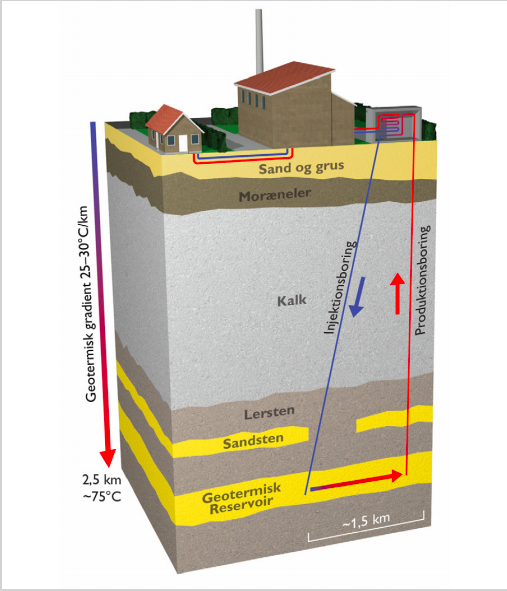Denmark
2005
- Type : Project
- Size : Regional
- Area : Industrial, Residential
Environmental benefit
Thisted District Heating and Cooling
Share
Denmark
2005
- Type : Project
- Size : Regional
- Area : Industrial, Residential
Environmental benefit
Discover this use case online

In 2014 Thisted District Heating had 5,057 consumers and 9 employees. The plant has since its establishment in 1961 supplied the consumers with district heating. The heat generation is based on renewable energy, supplemented with a smaller share of natural gas boilers for peak load. The system consists of CHP from waste incineration, natural gas boilers, geothermal energy, straw boiler and a smaller solar heating system (test facility). The majority of heat comes from the waste CHP and straw boiler, while approximately 11 % comes from geothermal energy; hot water delivered at 43 °C from the drilling.
Thisted District Heating A.m.b.a. and I/S Thyra each own 50 % of I/S CHP Thisted (waste incineration). I/S Thyra is owned by the municipalities: Morso, Jammerbugt and Thisted.
Thisted DH’s vision includes prioritizing green operation, security of supply and stable low prices. The majority of the heat supplied from Thisted DH is based on heat produced at the waste incineration CHP plant. The incineration plant was established in 1979 and has been renovated and rebuilt in 1991 for waste incineration. The plant has a capacity of 10.6 MW of heat and 2.9 MW of electricity. The waste treatment capacity is about 55,000 tonnes of combustible waste on annual basis. The waste comes partly from local citizens and partly from imports from abroad.
At the site of Thisted DH are several heat production units: The biomass boiler fuelled by straw, a geothermal plant, a small demonstration solar thermal system (CSP, concentrated solar power) and gas boilers. The straw is delivered from local farmers. In addition, a number of gas boilers and engines (CHP units) are placed at two other locations in Thisted. Natural gas boilers serve as peak and reserve capacity. In Hillerslev is a plant, which can be used as peak and reserve load for Hillerslev if Thisted DH is unable to supply sufficient heat to the area via the transmission line.
The existing geothermal plant has been operating since 1984. For many years the plant was partly owned by DONG Energy, while Thisted DH was responsible for the daily operations in all years. In 2011 Thisted DH took full ownership of the plant and the commitments as licensee and operator. The geothermal drilling is 1,243 m and has a flow capacity of 200 m 3 /h. The production of district cooling is done by pumping cold water from the soil under Thisted city. In summer, the excess heat from waste incineration is driving the absorption heat pump, and thus utilized in the cooling system.
 R-ACES has received funding from the European Union’s Horizon 2020 research and innovation programme under grant agreement N° 892429
R-ACES has received funding from the European Union’s Horizon 2020 research and innovation programme under grant agreement N° 892429
In 2014 Thisted District Heating had 5,057 consumers and 9 employees. The plant has since its establishment in 1961 supplied the consumers with district heating. The heat generation is based on renewable energy, supplemented with a smaller share of natural gas boilers for peak load. The system consists of CHP from waste incineration, natural gas boilers, geothermal energy, straw boiler and a smaller solar heating system (test facility). The majority of heat comes from the waste CHP and straw boiler, while approximately 11 % comes from geothermal energy; hot water delivered at 43 °C from the drilling.
Thisted District Heating A.m.b.a. and I/S Thyra each own 50 % of I/S CHP Thisted (waste incineration). I/S Thyra is owned by the municipalities: Morso, Jammerbugt and Thisted.
Thisted DH’s vision includes prioritizing green operation, security of supply and stable low prices. The majority of the heat supplied from Thisted DH is based on heat produced at the waste incineration CHP plant. The incineration plant was established in 1979 and has been renovated and rebuilt in 1991 for waste incineration. The plant has a capacity of 10.6 MW of heat and 2.9 MW of electricity. The waste treatment capacity is about 55,000 tonnes of combustible waste on annual basis. The waste comes partly from local citizens and partly from imports from abroad.
At the site of Thisted DH are several heat production units: The biomass boiler fuelled by straw, a geothermal plant, a small demonstration solar thermal system (CSP, concentrated solar power) and gas boilers. The straw is delivered from local farmers. In addition, a number of gas boilers and engines (CHP units) are placed at two other locations in Thisted. Natural gas boilers serve as peak and reserve capacity. In Hillerslev is a plant, which can be used as peak and reserve load for Hillerslev if Thisted DH is unable to supply sufficient heat to the area via the transmission line.
The existing geothermal plant has been operating since 1984. For many years the plant was partly owned by DONG Energy, while Thisted DH was responsible for the daily operations in all years. In 2011 Thisted DH took full ownership of the plant and the commitments as licensee and operator. The geothermal drilling is 1,243 m and has a flow capacity of 200 m 3 /h. The production of district cooling is done by pumping cold water from the soil under Thisted city. In summer, the excess heat from waste incineration is driving the absorption heat pump, and thus utilized in the cooling system.
